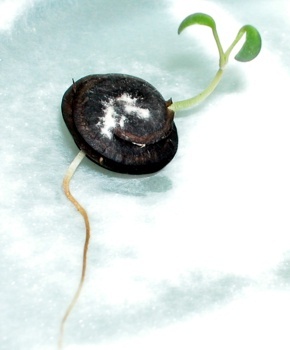Diseases
Fusarium spp. - Fusarium Disease of Alfalfa
Taxonomic position.
Mitosporic fungi, division Eumycota, subdivision Deuteromycotina, class Hyphomycetes, order Tuberculariales, family Tuberculariaceae genus Fusarium.Biological group.
Hemibiotrophic parasites.Morphology and biology.
Fusarium Disease of Alfalfa is caused by a Fusarium species complex. In this complex F. oxysporum dominates. The fungus is a causal agent of root rot and wilt. Leaves initially become whitish-yellow on one stem, later the other stems and the entire plant become chlorotic. The stem tip dries, or the whole plant dries up. The main root and root neck begin to rot. Sometimes the roots look healthy on the outside, but a brown color is observed on a section of the vascular system. Wilt usually appears on Alfalfa within 2-3 or more years. Arial mycelium on potato-saccharose agar is web-like or felted, low, pale-lilac or white. Macroconidia are not numerous, they are falcate, bent or nearly straight, formed on ramified conidiophores, with 3-5 septa, having identical diameters along most of length, with a non-lengthened apical cell narrowing gradually and regularly, with a pedicle at base, 27-60 x 3-5 microns. Microconidia are numerous, located in false heads, cylindrical, oval, ellipsoidal, unicellular, less often with one septum, 5-12 x 2.2-3.5 microns, formed on monophialids which form on hyphae or on short poorly ramified conidiophores. Chlamydospores are intermediate and apical, smooth, single and paired, round, hyaline, 3.5-7 microns.Distribution.
In the former Soviet Union it is registered in Voronezh Region, Rostov Regions, Stavropol, Krasnodar Territories, Baltic States, Ukraine (Poltava, Kharkiv Regions) and Uzbekistan (Toshkent).Ecology.
Development of the disease is promoted by high acidity, unstable water levels in soil, and high temperatures.Economic significance.
The disease causes destruction of Alfalfa and results in sparse crops. Protective actions: removal of vegetation residues, maintenance of crop rotation recommended for each zone, use of resistant cultivars.Reference citations.
Alpat.ev, N.N. & Shestiperova, Z.I. 1981. Fusarium fungi . phytopathogens of Alfalfa. Mikologiya i Phytopatologiya 15(1): 33-34. (in Russian).Hawksworth, D.L., Kirk, P.M., Sutton, B.C. & Pegler D.N. 1995. Ainsworth & Bisby's Dictionary of the fungi. 8th edition. Kew, Surrey: Commonwealth Mycological Institute, 616 p.
Karimov, M.A. 1961. Fungal parasites of Alfalfa. Tashkent: Ministry of agriculture of Uzbekistan, 208 p. (in Russian).
Kazantseva, T.P., Sorokin, N.S., Vasil'eva, I.A., Dolgova, T.M., Martynov, A. Ya., Gavrilova, E.A., Bakalova, G.A., Logvinenko, T.S., Bespalova, A.P., Chichikhina, T.V., Dolaberidze, S.D., Artokhin, K.S. & Makhota, V.M. 1997. Prognosis of incidence and distribution of pests, diseases of crops, weeds and quarantine objects on the territory of Rostov Region in 1997 and measures of control. Rostov-na-Donu: Yug. 128 p. (in Russian).
Petrovskaya, N.N. 1981. Fusarium diseases of Alfalfa in paramount zone of Krasnodar Territory. Bull. VIR 11: 64-69. (in Russian).
Zagovora, A.V. 1978. Forecast of pests and diseases distribution in crops in Khar.kov Region and their control. Khar.kov: Khar.kov Region station for plant protection, p. 35. (in Russian).


